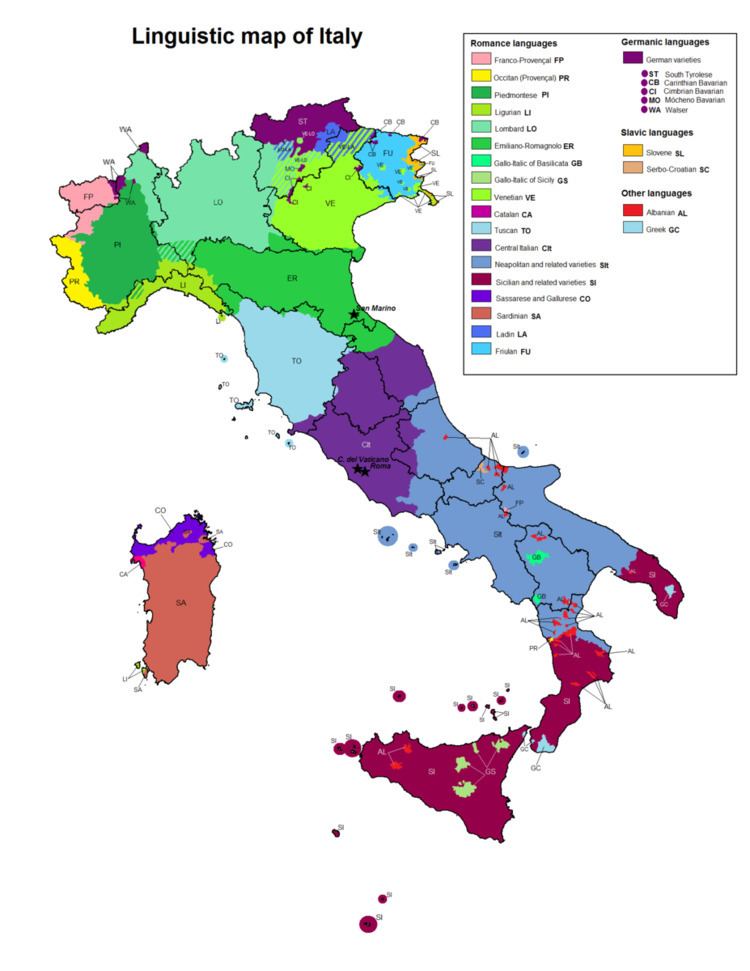Glottolog: gall1279 | ||
 | ||
Subdivisions: PiedmonteseLigurianLombardEmiliano-RomagnoloGallo-Italic of SicilyGallo-Italic of Basilicata | ||
The Gallo-Italian or Gallo-Italic languages constitute the majority of the languages of northern Italy. They are Piedmontese, Lombard, Emilian-Romagnol and Ligurian, although there is some doubt about the position of the latter due to a number of special characteristics. The Venetian language is usually considered one of the Italo-Dalmatian languages; however, some publications define it as Gallo-Italian.
Contents
- Geographic distribution
- General classification
- Phonology
- Vowels
- Consonants
- Isolated varieties in Sicily and in Basilicata
- References
The Gallo-Italian languages have characteristics both of the Gallo-Romance languages to the northwest (including French and Occitan) and the Italo-Dalmatian languages to the south (including Italian). Examples of the former are the loss of all final vowels other than -a; the occurrence of lenition; the development of original /kt/ to /jt/ (and often later to /tʃ/); and the development of front rounded vowels (e.g. the change of /u/ to /y/). Examples of the latter are the use of vowel changes to indicate plurals, in place of /s/; the widespread occurrence of metaphony of stressed vowels, triggered by original final /i/; and the development in some areas of /tʃ/ instead of /ts/ as the result of palatalisation of original /k/ before e and i.
As a result, there is some debate over the proper grouping of the Gallo-Italian languages. They are sometimes grouped with Gallo-Romance, but other linguists group them in Italo-Dalmatian.
Geographic distribution
Traditionally spoken in Northern Italy, southern Switzerland, San Marino and Monaco, most Gallo-Italian languages have given way in everyday use to Standard Italian. The vast majority of current speakers are bilingual with Italian. These languages are still spoken by the Italian diaspora in countries with Italian immigrant communities. Ligurian is formalised in Monaco as the Monégasque dialect (Munegascu).
General classification
Phonology
The Gallo-Italian languages differ somewhat in their phonology from one language to another, but the following are the most important characteristics, as contrasted with Standard Italian:
Vowels
Consonants
Isolated varieties in Sicily and in Basilicata
Varieties of Gallo-Italian languages are also found in Sicily, corresponding with the central-eastern parts of the island that received large numbers of immigrants from Northern Italy, called Lombards, during the decades following the Norman conquest of Sicily (around 1080 to 1120). Given the time that has lapsed and the influence from the Sicilian language itself, these dialects are best generically described as Gallo-Italic. The major centres where these dialects can still be heard today include Piazza Armerina, Aidone, Sperlinga, San Fratello, Nicosia, and Novara di Sicilia. Northern Italian dialects did not survive in some towns in the province of Catania that developed large Lombard communities during this period, namely Randazzo, Paternò and Bronte. However, the Northern Italian influence in the local varieties of Sicilian are marked. In the case of San Fratello, some linguists have suggested that the dialect present today has Provençal as its basis, having been a fort manned by Provençal mercenaries in the early decades of the Norman conquest (bearing in mind that it took the Normans 30 years to conquer the whole of the island).
Other dialects, attested from 13th and 14th century, are also found in Basilicata, more precisely in the province of Potenza (Tito, Picerno, Pignola and Vaglio Basilicata), Trecchina, Rivello, Nemoli and San Costantino. Because these have the same merger of Latin vowels that Dalmatian and Romanian languages do, they may be classified as Eastern Romance languages rather than as Gallo-Italic.
